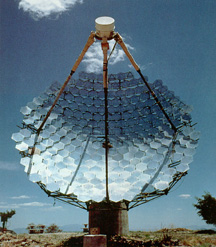 Purdue News
Purdue News
 Purdue News
Purdue News
 "This is the brightest source of high-energy gamma rays we have ever observed," says
James Gaidos, professor of physics at Purdue University and a member of the research
team. "In addition, the bursts were extremely rapid, with the first occurring over
less than a day and the second in less than half an hour."
"This is the brightest source of high-energy gamma rays we have ever observed," says
James Gaidos, professor of physics at Purdue University and a member of the research
team. "In addition, the bursts were extremely rapid, with the first occurring over
less than a day and the second in less than half an hour."
Previous flares observed from the distant galaxy consisted of a few gamma rays per minute hitting the team's detector over several days.
Another member of the team, John Finley, assistant professor of physics at Purdue, says the current models describing such gamma-ray flares predict that variations should occur, but on the scale of days.
"No model predicts anything happening this fast," Finley says. "These flares occurred much faster than any theory can explain at this point."
The researchers report their observations -- made during eight days in May -- in the Sept. 26 issue of the journal Nature.
In the past four years, the team of astronomers working at the Smithsonian's Fred Lawrence Whipple Observatory in Arizona has observed high-energy gamma-ray bursts coming from the active galactic nucleus known as Markarian 421, a galaxy some 400 million light-years from Earth. Gamma rays are highly energetic photons, and very high-energy gamma rays carry with them energies of trillions of electron volts, a level that is hundreds of billions of times greater than visible light.
Scientists presume that the energy engine powering Markarian 421 is a super-massive black hole at the core of the galaxy, and theorize that the gamma rays may originate in very fast-moving jets of matter that erupt from the region surrounding the black hole. A black hole is formed when stars and other material in a galaxy's core are compressed to enormous densities by gravity. The resulting gravitational field is so strong that nothing, not even light, can escape.
The researchers counted 15 gamma rays per minute during the first flare from Markarian 421, 10 times as high as the rate observed from the Crab Nebula, which is a steady source of high-energy gamma rays in our own galaxy.
By using mathematical equations that relate the duration of the flare to the size of the region emitting the bursts, Gaidos says the rapidity of the second flare suggests that the region emitting the gamma rays is extremely small on an astrophysical scale, perhaps even smaller than our solar system.
Another unusual feature of Markarian 421 is that it is bright at both the low and high ends of the energy spectrum, but emits only a weak signal in certain regions of gamma rays.
"This particular object radiates only faintly in the energy region where gamma rays have an energy of a few hundred million electron volts," explains Gaidos. "This is the region where the detector on NASA's orbiting Compton Gamma Ray Observatory makes observations.
"Just why Markarian 421 radiates in this unusual manner is a question scientists are very interested in and are currently investigating."
The research reported in the Nature paper is the result of collaborative efforts of scientists from Purdue; the Harvard-Smithsonian Center for Astrophysics; Iowa State University; the University of Michigan; the University of Leeds, United Kingdom; University College in Ireland; St. Patrick's College, Ireland; and Regional Technical College, Ireland.
Other team members from Purdue are Glenn Sembroski and Charles Wilson, senior research scientists. The research is funded by the U.S. Department of Energy.
Sources: James Gaidos, (765) 494-5171; e-mail, gaidos@purdd.physics.purdue.edu
John Finley, (765) 494-5048; e-mail, finley@physics.purdue.edu
Writer: Amanda Siegfried, (765) 494-4709; e-mail, amanda_siegfried@purdue.edu
Purdue News Service: (765) 494-2096; e-mail, purduenews@purdue.edu
NOTE TO JOURNALISTS: A color photo of the telescope used to detect gamma ray bursts is available from Purdue News Service, (765) 494-4709. Ask for the photo called Gaidos/Gamma or download here.
Photo Caption
Purdue astrophysicists and their colleagues at several institutions used this telescope,
at the Whipple Observatory on Mount Hopkins in Arizona, to detect very-high-energy
gamma-ray bursts from a galaxy 400 light-years from Earth. The 10-meter-diameter
spherical mirror is made up of many smaller mirrors. The detector on the telescope consists
of 109 photomultiplier tubes that amplify a light signal. The gamma rays are not
observed directly, but are detected by how they interact with the Earth's atmosphere.
(Photo courtesy James Gaidos, Purdue Physics Department)
Color photo, electronic transmission, and Web and ftp download available. Photo ID:
Gaidos/Gamma
ABSTRACT
Extremely Rapid Bursts of TeV Photons From the Active Galaxy Markarian 421
J. Gaidos, J.P. Finley, G.H. Sembroski, C.L. Wilson, Purdue University; University
of Michigan; University of Leeds, UK; University College Dublin, Ireland; Harvard-Smithsonian
Center for Astrophysics; Iowa State University; St. Patrick's College, Ireland; and Regional Technical College, Ireland.